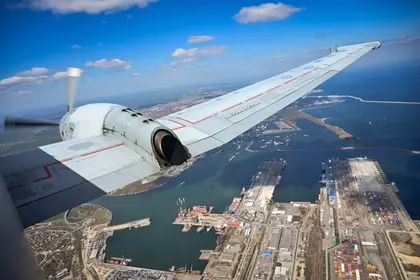The Ministry of National Defense of Romania has strengthened limits on aircraft and drone flights near to the border with Ukraine, extending the no-fly corridor out to 20-30 kilometers.
“In response to the increasing Russian attacks on Ukrainian ports, there was a necessity to enhance previously implemented measures,” the Ministry of Defense of Romania (RMoD) announced on Thursday, Sept. 14 as quoted by Moldova’s NewsMaker website.
- Look at the latest Ukraine news that was released today.
- Look at the most up-to-date Ukraine news that came out today.
JOIN US ON TELEGRAM
Follow our coverage of the war on the @Kyivpost_official.
“This will enable more effective monitoring and control of airspace usage.”
The airspace has been restricted to within a minimum 20-30 kilometers from the Ukrainian border, with a minimum altitude limit of 4,000 meters inside the prohibited area.
The previous no-fly limit was set at only 8 kilometers along the Ukrainian border at a minimum altitude of 1,000 meters.
The ministry clarified that these restrictions would not apply to civilian aircraft flights to and from the Tulcea Danube Delta Airport area or to state aircraft and air transport operated by the SMURD emergency and rescue service.
The RMoD has discovered wreckage that originated from Russian drones on three separate occasions in the past week. The most recent discovery occurred on Sept. 13 following a Russian attack on Ukraine’s Odesa region.
On that day, residents of villages in the Tulcea district received an RO-Alert message, warning of an air threat, for the first time during a Russian drone attack on the Odesa region.

Trump’s Russia Plan – Will It Work? NATO, Putin & US Strategy Explained
The message included a warning about the potential risks from falling drone debris with the following message as reported by the local publication Digi24:
“There is a possibility of objects falling from the air. Please remain calm and seek shelter in basements or civil defense shelters. If no shelter is available, stay indoors, away from windows and external walls.”
On Sept. 7, Romania's National Committee for Emergency Situations decided there was a need to notify residents of the border zone in the event of a Russian attack on southern Ukraine’s Danube ports, following a previous barrage.
Media reports also noted the construction of shelters for residents of a Romanian village close to the banks of the Danube, who were at risk from the ongoing Russian missile bombardment of Ukrainian ports on the opposite bank.
Following the incident on Sept. 13, Romanian Prime Minister Ion-Marcel Ciolacu reassured the public that the country was not under attack.
“This is all a coincidence; there were remnants of drones crossing the Danube. We are not discussing an attack on Romania,” Ciolacu was quoted by Digi24.
“Let's calm the population down because we are all getting anxious. No one has attacked us, and no one is attacking us.”
He mentioned that fragments from a drone shot down by the Ukrainian army were discovered but did not contain any explosives or other harmful material.
Ciolacu assured his people that the situation near the Ukraine border was under control and that, while the shelters being set up in the area were not attractive, they were a rapid response because “people do not feel safe.”
Romania has been a member of NATO since March 29, 2004, as part of the Alliance's largest expansion in advance its Istanbul Summit in June of that year.
Correction: A previous version of this article stated the new restrictions had a "maximum altitude limit of 4,000 meters." It is actually a "minimum altitude limit of 4,000 meters."
You can also highlight the text and press Ctrl + Enter










